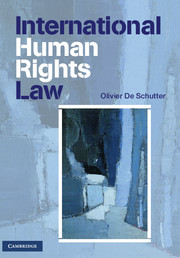Book contents
- Frontmatter
- Contents
- Table of Cases
- Table of Treaties and Conventions
- Table of Comments and Recommendations of Various International Committees
- Introduction
- PART I THE SOURCES
- PART II THE SUBSTANTIVE OBLIGATIONS
- PART III THE MECHANISMS OF PROTECTION
- 8 Ensuring compliance with international human rights law: the role of national authorities
- 9 The United Nations human rights treaties system
- 10 The United Nations Charter-based monitoring of human rights
- 11 Regional mechanisms of protection
- Index
10 - The United Nations Charter-based monitoring of human rights
from PART III - THE MECHANISMS OF PROTECTION
- Frontmatter
- Contents
- Table of Cases
- Table of Treaties and Conventions
- Table of Comments and Recommendations of Various International Committees
- Introduction
- PART I THE SOURCES
- PART II THE SUBSTANTIVE OBLIGATIONS
- PART III THE MECHANISMS OF PROTECTION
- 8 Ensuring compliance with international human rights law: the role of national authorities
- 9 The United Nations human rights treaties system
- 10 The United Nations Charter-based monitoring of human rights
- 11 Regional mechanisms of protection
- Index
Summary
INTRODUCTION
The United Nations Charter-based system of human rights monitoring has been through major changes in 2006–7. Acting under Article 68 of the UN Charter, the Economic and Social Council (Ecosoc) had established the Commission on Human Rights as an inter-governmental body initially composed of eighteen Member States. The membership of the Commission on Human Rights was progressively expanded to fifty-three members in 2006 to take account of the more diverse membership of the United Nations. The Commission was assisted in its work by the UN Sub-Commission for the Promotion and Protection of Human Rights, until 1999 called the Sub-Commission on Prevention of Discrimination and Protection of Minorities. Despite major achievements, the system thus developed was considered to be overpoliticized, and to lack credibility due, in particular, to the selective approach to the human rights records of governments. In its place, it was decided in 2005 to establish a Human Rights Council, as a subsidiary organ of the UN General Assembly, whereas the former Commission on Human Rights was one of a number of subsidiary bodies of the Ecosoc.
This chapter examines how this change came about, and which tools the Human Rights Council has at its disposal to promote and protect human rights (for useful presentations, see P. Alston, ‘Reconceiving the UN Human Rights Regime: Challenges Confronting the New Human Rights Council’, Melbourne Journal of International Law, 7 (2006), 185; K. Boyle (ed.), New Institutions for Human Rights Protection (Oxford University Press, 2009), chapters 1 – 3 ; G. Luca Burci, The United Nations Human Rights Council’ in Italian Yearbook of International Law , XV (2005), 25: F. D. Gaer, ‘A Voice Not an Echo: Universal Periodic Review and the UN Treaty Body System’, Human Rights Law Review , 7, No. 1 (2007), 109; N. Ghanea, ‘From UN Commission on Human Rights to UN Human Rights Council: One Step Forwards or Two Steps Sideways’, International and Comparative Law Quarterly , 55, No. 3 (2006), 695; F. Hampson, ‘An Overview of the Reform of the UN Human Rights Machinery’, Human Rights Law Review , 7, No. 1 (2007), 7; P. G. Lauren, ‘ “To Preserve and Build on Its Achievements and to Redress Its Shortcomings”: the Journey from the Commission on Human Rights to the Human Rights Council’, Human Rights Quarterly , 29 (2007), 307).
- Type
- Chapter
- Information
- International Human Rights LawCases, Materials, Commentary, pp. 855 - 896Publisher: Cambridge University PressPrint publication year: 2010



